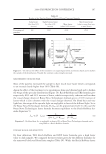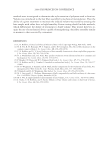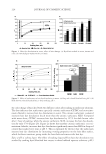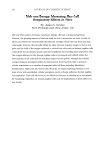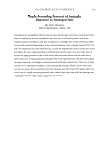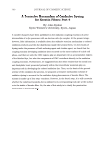2008 TRI/PRINCETON CONFERENCE 169 adapted to the polarization analysis. This new formula is a modifi ed Reich-Robbins formula. It gives a high dynamic range and high sensitivity to small changes of luster. This new luster permits measurement of every type of hair. It gives improved results in terms of dynamic for dark hair and converges toward Reich-Robbins and TRI formulae for light hair. The combination of the polarization imaging technique and the new luster formula leads to a complete measurement of hair visual appearance. REFERENCES (1) R. Schueller and P. Romanowski, Evaluating shine on hair, Cosmet. Toiletr., 116(12), 47–52 (2001). (2) R. S. Hunter, Methods of determining gloss, J. Res. Natl. Bur. Stand., 18, 19–39 (1939). (3) C. Reich and C. R. Robbins, Light scattering and shine measurements of human hair: A sensitive probe of the hair surface, J. Soc. Cosmet. Chem., 44, 221–234 (1993). (4) H. Bustard and R. Smith, Investigation into the scattering of light by human hair, Applied Optics, 24(30), 3485–3491 (1991). (5) W. Czepluch, G. Hohm, and K. Tolkiehn, Gloss of hair surfaces: Problems of visual evaluation and pos- sibilities for goniophotometric measurements of treated strands, J. Soc. Cosmet. Chem., 44, 299–317 (1993). (6) F.-J. Wortmann, E. Schulze Zur Wiesche, and A. Bierbaum, Analyzing the laser-light refl ection from human hair fi bers. I. Light components underlying the goniophotometric curves and fi ber cuticle an- gles, J. Cosmet. Sci., 54, 301–316 (2003). (7) R. F. Stamm, M. L. Garcia, and J. J. Fuchs, The optical properties of human hair. I. Fundamental con- siderations and goniophotometer curves, J. Soc. Cosmet. Chem., 28, 571–600 (1977). (8) R. F. Stamm, M. K. Garcia, and J. J. Fuchs, The optical properties of human hair. II. The luster of hair fi bers, J. Soc. Cosmet. Chem., 28, 601–609 (1977). (9) A. Guiolet, J. C. Garson, and J. L. Levecque, Study of the optical properties of human hair, Int. J. Cosmet. Sci., 9, 111–124 (1987). (10) C. Edward, Polarized Light (Marcel Dekker, New York, 1993). (11) D. H. Goldstein, Polarized Light (Marcel Dekker, New York, 2003). (12) E. A. Chipman, “Polarimetry,” in Handbook of Optics, 2nd ed., M. Bass, Ed. (McGraw-Hill, New York, 1995), Ch. 2. (13) S. Breugnot, L. Le Hors, D. Dolfi , and P. Hartemann, Phenomenological model of paints for multispec- tral polarimetric imaging, AeroSense, Orlando (2001). (14) S. R. Marschner, H. W. Jensen, Mike Cammarano, S. Worley, and P. Hanrahan, Light scattering from human hair fi bers, Siggraph (2003). (15) K. Keis, K. R. Ramaprasad, and Y. K. Kamath, Studies of light scattering from ethnic hair fi bers, J. Cosmet. Sci., 55, 49–63 (2004). (16) P. Kaplan, K. Yang, K. Park, and R. Ramaprasad, Shine and color: Interplay of angle-dependent optical measurements and visual attributes with cosmetic treatment, Third Annual Conference on Applied Hair Science (2008). (17) K. Keis, K. R. Ramaprasad, and Y. K. Kamath, Effect of hair color on luster, Int. J. Cosmet. Sci., 27(1), 33–35 (2005).
J. Cosmet. Sci., 60, 171–185 (March/April 2009) 171 Measurements of hair volume by laser stereometry ROGER MCMULLEN, FRANCO ZISA, and JANUSZ JACHOWICZ,* International Specialty Products, Wayne, NJ. Synopsis A three-dimensional laser stereometer was constructed utilizing an x-y two-dimensional translational stage and a laser device, which provides distance information in the z-direction. The distance data is obtained by triangulation of the refl ecting red laser beam from the surface of the measured object, in this case hair. Since hair fi ber assemblies do not have a continuous solid surface, each z-dimension reading is obtained as an aver- age of measurements obtained from multiple refl ections corresponding to fi bers at various depths below the outermost hair surface. We demonstrate the utility of this technique to perform the analysis of either an en- tire hair tress or relatively short sections of tresses prepared from straight, curly, and frizzy hair and subjected to cosmetic treatments such as washing, conditioning, dyeing, etc. An interpretation is provided for the three-dimensional images of hair assemblies as well as for the calculated volume of space occupied by a hair tress. In addition, we investigated various strategies for testing the volume retention of styling polymers. INTRODUCTION Hair body is one of the most important attributes for the hair care consumer. It is a com- plex phenomenon that describes the three-dimensional state of one’s hair and often al- ludes to the overall mechanical properties of the hair fi ber assembly. Several single fi ber properties are thought to be responsible for hair body and include curvature, friction, stiffness, diameter, cohesion, or weight of the individual fi bers that comprise the hair fi - ber assembly (1–3). Based on consumer research in conjunction with principal compo- nent analysis (a statistical technique), it was found that three words, together, describe body: volume (bulk, thickness), springiness (bounce), and stiffness (of the hair-set, not soft) (4). Other studies have emphasized the structural strength and resiliency of a hair mass as the predominant characteristics responsible for consumer-perceivable body (5). These studies were followed by the development of techniques to evaluate hair body based on the amount of work required to pull a hair tress through a specially designed template or utilizing a radial compressibility apparatus (6–9). Hair volume is recognized as a key component of hair body, and several attempts have been made to measure the three-dimensional volume of a hair-fi ber assembly (10,11). In this account, we describe a technique to measure hair volume by three-dimensional laser stereometry and demon- strate how physical properties of the hair fi ber assembly infl uence the volume. *The current address of Janusz Jachowicz is International Specialty Products, LLC, Bethel, CT.
Purchased for the exclusive use of nofirst nolast (unknown) From: SCC Media Library & Resource Center (library.scconline.org)














































































